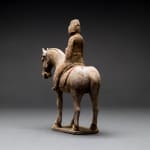Tang Polychrome Horse and Female Rider, 618 CE - 906 CE
Painted Terracotta
height 34.3 cm
height 13 1/2 in
height 13 1/2 in
H.970
Further images
During the Tang Dynasty, horses were revered creature, considered relatives of the mythical dragon. This veneration was well earned, for the speed and stamina of these majestic animals ensured the...
During the Tang Dynasty, horses were revered creature, considered relatives of the mythical dragon. This veneration was well earned, for the speed and stamina of these majestic animals ensured the protection of the northern borders against barbarian invaders as well as enhancing communication capabilities between far away provinces, thereby aiding in the expansion of the empire. The need to import horses from Central Asia influenced the creation of the Silk Road. Thus, they were also prized for their rarity. Naturally then, horses became a status symbol for the aristocratic elite. Polo and other equestrian activities were popular pastimes. This sculpture, depicting a hooded man riding on the back of a white steed, reveals this connection between nobility and the horse. His cloak still retains a majority of its original white pigment, highlighted with red stripes. The horse’s harnesses are also represented by strokes of black paint while his nose and mouth are enhanced by vibrant red. We can imagine this rider marching with his steed in part of an important ceremony. A hole in his right hand suggests that he was once carrying a staff or spear that has long since deteriorated over the centuries. Discovered buried inside a tomb, this work was supposed to accompany the deceased throughout the afterlife. The striking beauty of this work is even more impressive, considering that it was created specifically for interment and was not supposed to be seen by the living. Today, we marvel in the beauty of this sculpture as much as its tremendous history and intriguing legacy.









